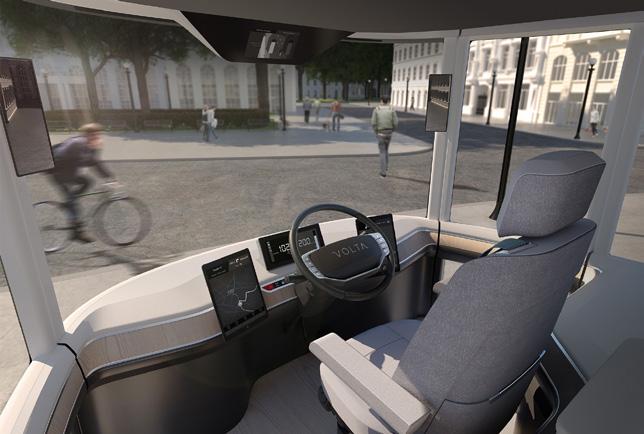
5 minute read
Science: A Green Game-changer
Science
A Green Game-changer
By Anne Kvist
With a worldwide focus on finding alternatives to fossil fuels, the methanol fuel cell technology plays a vital part in the green transition.
Back in October 2018, Blue World Technologies was founded with the purpose of developing and manufacturing methanol fuel cell systems for a variety of industries including the transportation sector. Blue World Technologies is located in Aalborg, Denmark which is a hotspot for green energy technology such as Power-to-X technologies. Aalborg University is also located in the same city and is ranked as the best university in Europe within the field of engineering.
The idea of working with liquid methanol instead of gaseous fuel for the Blue World fuel cells originated from the challenges there would be by having to introduce a gaseous fuel into a fuelling infrastructure that has been producing, storing, distributing, and selling liquid fuel for more than a century.
Methanol is a high-density energy carrier which is liquid at atmospheric pressure, making it simple and cost-effective to refuel and store in large volumes, and it is already widely available around the world. Compared to hydrogenpowered fuel cells, a methanol fuel cell system eliminates some of the
Methanol fuel cell production. Photo: Blue World Technologies, www.blue.world
difficult challenges linked to handling and distribution, infrastructure investments, and low volumetric energy density. Methanol, on the other hand, is an easy-to-use e-fuel, as it is a liquid fuel providing the same convenient refuelling experience we have today with gasoline and diesel vehicles. At the same time, methanol is a fuel that allows integration and reuse in the existing world-wide infrastructure. Also, methanol is a fuel that can be produced from green sources, and if that is the case the fuel will be CO2 neutral from a wellto-wheel perspective. Therefore, it is a safe and sound alternative to fossil fuel and can contribute to the green transition in multiple industries around the world.

Retiring the combustion engine
With the aim to make a significant difference in the world when it comes to climate change and air pollution, Blue World Technologies is set out to commercialise the fuel cell technology so it can benefit the climate and environment around the globe. The methanol fuel cell technology has great potential in several markets such as maritime, heavy-duty, stationary, and passenger vehicles when direct electrification is not possible or feasible. As a green and clean alternative to combustion engines and diesel generators, the methanol fuel cell technology provides multiple benefits such as cost-savings and CO2 reduction – or even a CO2 neutral operation when running on green methanol. At the same time, the technology eliminates the emission of nitrogen oxide, sulfur oxide, and particle matter. This is an important factor alongside the climate challenges, as 91 percent of the world’s population lives in areas where the air pollution exceeds WHO guidelines. One of the biggest offenders for this is the transportation sector.
A methanol fuel cell system is equipped with an onboard reformer converting the liquid methanol into a hydrogen-rich gas. The fuel cell converts the reformate gas into electricity feeding an electric motor that could, for example, be powering a passenger car. The combination of onboard reforming and the high-temperature proton-exchange membrane (PEM) fuel cell technology results in a system with high electrical efficiency and many other benefits which will push the global green transition in the right direction.

Hemma hos
By Kristi Robinson
Electric cars are now commonplace, but large transports have been reliant on fuel-powered engines, up until now. Enter Sweden’s Volta Zero, the world’s first fully electric 16-tonne delivery vehicle. Entrepreneur and Volta Trucks founder, Carl-Magnus Norden, recognized the impact of heavy goods vehicles (HGV) on air quality in big cities and set out to do something about it.
With a range between 150 and 200 km (95 – 125 miles), the Volta Zero is designed for parcel and freight deliveries within cities. It runs purely on electricity and has no tailpipe emissions. Though definitely an achievement for an HGV, it is just the beginning of Volta Zero’s ingenuity – setting out to be the most sustainable truck in the world. On a trail of firsts, the truck is the first in the world to use carbon neutral body panels made from flax fiber and biodegradable rapeseed oil resin composite. Performance-wise, the material matches the weight and stiffness of typical carbon fiber panels, but from an environmental

[Design]

perspective Volta Zero really stands out. It is estimated that the manufacture of these composite panels will eliminate 180,000 tonnes of CO2 by 2025. Moreover, while traditional HGV materials are sent to landfill at the end of the vehicle’s lifespan, the plan for Volta Zero is to burn the composite panels for thermal energy.
While Volta Zero has made sustainability a priority by considering the complete life cycle of their truck, it is safety that matters most. Norden says that in London 23 percent of pedestrian and 58 percent of cyclist fatalities involve a heavy goods vehicle, even though they only account for 4 percent of road miles. Again, Volta Zero stepped out of the box and looked at how they could best redesign the HGV to change all this. With electric vehicles there is no need for an internal combustion engine, so this frees up a lot of space that would be otherwise limited by a large front engine. Capitalizing on this, Volta Zero has put the driver in the center of the cab, in a low position. Placing the driver at 1.8 meters above ground – about the same height as pedestrian, cyclist, and other vehicular traffic – makes it much easier for visual communication between the Volta Zero driver and the world outside. The cab itself is designed in a glass house style, minimizing blind spots and giving the driver a 220-degree view. Visibility is enhanced by a rear-view camera instead of mirrors, along with a 360-degree birds-eye camera. To reduce driver error and distraction, the cab is designed to reduce cognitive overload. The user interface is intuitive; important information is shown on a central display, and other features like lights, climate control, and media are located on touch screens on either side. Volta describes the experience comparable to driving a premium car rather than a typical commercial vehicle.
Aiming to participate in the vision for zero-emission cities around the world, the Volta Zero design could have an impact beyond the company’s own fleet, paving the way for other truck manufacturers. On track to have their first prototype by the end of this year, Volta Zero’s pilot fleet will do trials in Europe in 2021 and begin production in 2022.

Photos © Volta Trucks










